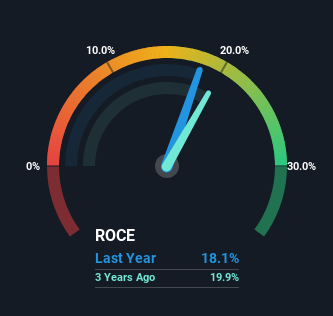Karat Packaging (NASDAQ:KRT) Shareholders Will Want The ROCE Trajectory To Continue
There are a few key trends to look for if we want to identify the next multi-bagger. Ideally, a business will show two trends; firstly a growing return on capital employed (ROCE) and secondly, an increasing amount of capital employed. Ultimately, this demonstrates that it's a business that is reinvesting profits at increasing rates of return. So on that note, Karat Packaging (NASDAQ:KRT) looks quite promising in regards to its trends of return on capital.
Understanding Return On Capital Employed (ROCE)
For those that aren't sure what ROCE is, it measures the amount of pre-tax profits a company can generate from the capital employed in its business. Analysts use this formula to calculate it for Karat Packaging:
Return on Capital Employed = Earnings Before Interest and Tax (EBIT) ÷ (Total Assets - Current Liabilities)
0.18 = US$42m ÷ (US$279m - US$48m) (Based on the trailing twelve months to March 2024).
Therefore, Karat Packaging has an ROCE of 18%. In absolute terms, that's a satisfactory return, but compared to the Trade Distributors industry average of 13% it's much better.
View our latest analysis for Karat Packaging
Above you can see how the current ROCE for Karat Packaging compares to its prior returns on capital, but there's only so much you can tell from the past. If you'd like, you can check out the forecasts from the analysts covering Karat Packaging for free.
How Are Returns Trending?
Investors would be pleased with what's happening at Karat Packaging. The numbers show that in the last five years, the returns generated on capital employed have grown considerably to 18%. The company is effectively making more money per dollar of capital used, and it's worth noting that the amount of capital has increased too, by 180%. The increasing returns on a growing amount of capital is common amongst multi-baggers and that's why we're impressed.
On a related note, the company's ratio of current liabilities to total assets has decreased to 17%, which basically reduces it's funding from the likes of short-term creditors or suppliers. Therefore we can rest assured that the growth in ROCE is a result of the business' fundamental improvements, rather than a cooking class featuring this company's books.
What We Can Learn From Karat Packaging's ROCE
To sum it up, Karat Packaging has proven it can reinvest in the business and generate higher returns on that capital employed, which is terrific. And with a respectable 62% awarded to those who held the stock over the last three years, you could argue that these developments are starting to get the attention they deserve. With that being said, we still think the promising fundamentals mean the company deserves some further due diligence.
If you want to continue researching Karat Packaging, you might be interested to know about the 1 warning sign that our analysis has discovered.
While Karat Packaging may not currently earn the highest returns, we've compiled a list of companies that currently earn more than 25% return on equity. Check out this free list here.
Have feedback on this article? Concerned about the content? Get in touch with us directly. Alternatively, email editorial-team (at) simplywallst.com.
This article by Simply Wall St is general in nature. We provide commentary based on historical data and analyst forecasts only using an unbiased methodology and our articles are not intended to be financial advice. It does not constitute a recommendation to buy or sell any stock, and does not take account of your objectives, or your financial situation. We aim to bring you long-term focused analysis driven by fundamental data. Note that our analysis may not factor in the latest price-sensitive company announcements or qualitative material. Simply Wall St has no position in any stocks mentioned.
Have feedback on this article? Concerned about the content? Get in touch with us directly. Alternatively, email editorial-team@simplywallst.com

 Yahoo Finance
Yahoo Finance 
